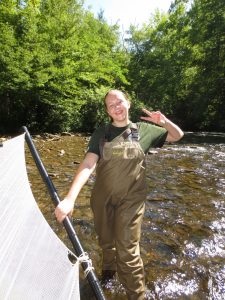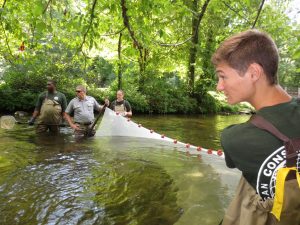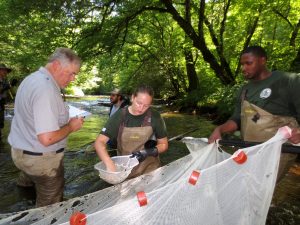Lorien Helm, a freshman at Western Carolina University, participated in the Great Smoky Mountains National Park’s high school internship program for six weeks this past summer. In this post, she shares her experience working with the Fisheries program in surveying fish in Deep Creek. She called the experience “an eye-opening research opportunity.”
by Lorien Helm
The internship with the Great Smoky Mountains National Park was an amazing way to kick off the summer after my high school graduation as I prepared to head to Western Carolina University.

The experiences I had in the internship will help me through my continued education in biology, as I got the privilege of working with biologists all across the Great Smoky Mountains National Park.
Research opportunity
One example of an eye-opening research opportunity was during week five of our internship. We worked with Fisheries led by Matt Kulp and assisted by us in the GSMNP high school internship program and various volunteers and seasonal park workers.
The first thing we did was to split into two groups so that we could collect data at multiple sites.
One group went up to Indian Creek while my group stayed at Deep Creek to do three different types of surveys.
First we geared up in our waders and rubber gloves in order to protect us from both the electrofishing (using a large backpack battery and two conductor rods, a current is run through the water in order to stun the fish) and from getting soaked in the cold stream water.
Net pull survey method
One type of survey that we did was a net pull where two people take a large drag net and walk it out into a large pool. Then, they turn around and quickly wade back to shore trapping fish in the net. When we had little luck with that method, we switched to electrofishing.
Electrofishing survey method
In electrofishing, three people with electrofishing kits walk through the water shocking the fish while people downstream use the large drag net to catch the stunned fish. (See the photo at the top of this blog post.) We wore rubber gloves and waders in order to avoid being shocked ourselves.
This method was very successful and we collected species data counts from three different areas, pools, riffles and runs. The data collected helps us see where different species of fish live in the different sections of the creek and whether or not the native species of the creek are flourishing.
Bank sample survey method
The last type of survey we did was a bank sample. We selected 30 feet of creek bank, and three people worked together to sample it. One person had an electrofishing kit and walked along the bank. Another person used a net to collect the stunned fish and place them in the bucket that the third person held.
More than 100 fish in survey

With all three survey methods, we recorded what kind of fish we caught and how many to if the different fish populations are healthy.
After we were done recording the fish, we released them back into the stream.
We surveyed more than a hundred fish in just one day. That gave us amazing insight into the health and ecology of the waterway.
The purpose of these surveys is to see if there are sufficient populations of the fish that live in the different areas of the stream.
By taking samples from different areas, we can use the data to see if the fish population is healthy or if the population is having long-term problems due to habitat loss, over-fishing, or pollutants in the water.
We also can track the fluctuation of the fish populations to see how floods, droughts and other natural causes may affect them.
Survey results

We found many different species of fish, both native and non-native to the Smokies.
Some species we found include the Mottled sculpin, Longnose dace, Mountain brook lamprey, and all three species of trout found in the park — rainbow, brown and brook trout.
The brook trout is the only trout species native to the park. Both the rainbow and the brown trout were introduced in the 1900s.
Now 75 percent of the brook trout’s native territory has been lost throughout the park. Continued surveying is important in order to track the populations of this and other vulnerable fish species in the park.
This day taught me a lot about how biologists collect data out in the field and the importance of making sure that we have healthy native fish populations.
***
This is the second post by students who participated in the Great Smoky Mountains National Park Summer Internship Program this year. The students represent high schools in North Carolina and Tennessee that are near Great Smoky Mountains National Park.
Intern Stuart Hemmer-Skidmore wrote a post introducing the program.
The program is designed to give the interns a little taste of a variety of activities that rangers are involved with – from fisheries science to botany to forest and stream ecology. The interns gain an understanding of how the park is managed and are introduced to possible career opportunities.
This summer, nine students from North Carolina and five from Tennessee participated in the program. North Carolina also had three interns working with Asheville Greenworks who joined the high school intern program in the Smokies on Mondays and Tuesdays. The addition of the Asheville Greenworks interns was sponsored by FOTS.
GSMNP staff involved with the program included Erin Lamm, who supervised the North Carolina interns, Julianne Geleynse, who supervised the the Tennessee interns, Max Lanning, who worked as a Teacher in Parks, Joéle Emma, Director of Education at Asheville Greenworks, and Susan Sachs, Nigel Fields and the Park Administration, who supported the program.
 Erin Lamm provided the photographs for the interns’ posts.
Erin Lamm provided the photographs for the interns’ posts.
FOTS helped support the program for 16 years, initially providing the salaries for the interns and then funding the program staff salaries. To help support programs like this, you can make a donation online.
